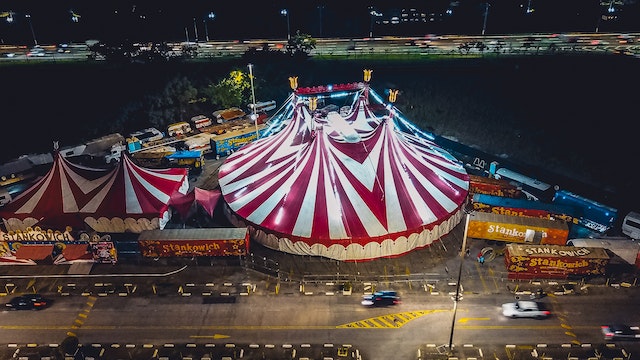
Where did the circus come from? The modern circus was invented in 1768, but the idea of a show in an amphitheater goes back thousands of years.
The word “circus” comes from Greek, through Latin into English. It simply means “ring” or “circle” and the Romans used them to show horse and chariot races, battle reenactments, and gladiatorial fights. The Romans took the idea from the Greeks, who had used a hippodrome for horse races and chariot races. The Romans took the idea and made it larger. Even though the name meant circle, the Roman circus was usually an oblong because a race track usually had two long straights and two curves at each end. The circus was usually outside and open to the elements.
The most famous circus in Rome was the Circus Maximus. It was said to be able to seat 150,000 people. Different emperors added to it and held triumphs there. Julius Caesar held his own triumph there and had more seats built so people could see him. The colosseum was built in about AD 80 and took over from the Circus Maximus for gladiatorial fights and battles, but the Circus Maximus was in use until the 6th century AD.
After the Fall of the Roman empire, centers of entertainment fell out of use. Travelling performers would go from town to town trying to earn money. Sometimes a Lord might hold a show in their castle.
Englishman Philip Astley is credited with inventing the modern circus on the 4th April 1768. However, he didn’t use the word “circus” and he didn’t invent the idea of a “circus”. He called the performance space a “circle” and the building an “amphitheater”.
Astley was a cavalry officer and he had ridden with the Fifteenth Light Dragoons and served in the seven years war. He was an excellent rider and he had a knack for making horses do what he wanted. After he retired from the army, he was thinking about opening a riding school when he saw some trick horse riders performing. The crowd loved it and he realized that was something he could do.
He wanted a space where he could perform his horse-riding tricks and people could pay to watch him, so he rented some land in Lambeth. Many performers of the day rode in a straight line, but Astley realized that more people could watch him if he rode in a circle. He performed in a 13-meter diameter ring, which has since become the standard size for most circus rings. This was by pure chance because that was the exact distance he needed to use centrifugal force to keep him on a horse’s back when he rode at speed. After a few shows he realized that the audience were getting restless between his performances, so he hired a clown to entertain them. Clowns have been around for thousands of years, and Astley certainly did not invent those. After his horse-riding show became popular, he hired acrobats, jugglers, tight rope walkers, and other performers. He did not set out to create a circus, but, it appears by chance, he did create an arena where lots of different performers could entertain people, thereby creating the modern idea of a circus.
After the Industrial Revolution, more people were living in the cities and Philip Astley popularized this idea of having a place in a city where people could go to watch entertainers. His “circus” became hugely popular, and he was invited to France to perform before Louis XV. By 1780, he had built a roof over his circus. As with any good idea, other people began to make circuses of their own. The word “circus” was first used by Charles Dibdin in 1782, and it stuck. Dibdin was a composer who decided to form a circus along the lines of Astley’s, except using his own music. He formed the Royal Circus.
In 1792, John Bill Ricketts, who had trained at Charles Dibdin’s circus, travelled to America and started his own circus. It wasn’t very successful, but it was the first. Other circuses started to pop up around the country, but they were always in permanent buildings, and they were based mostly around horse displays. In 1825, the big top tent was invented, which meant a circus no longer had to be in an existing building, and in the 1870s, PT Barnum revolutionized the idea of the circus by introducing the travelling circus. From this point on, circuses grew larger, bolder, and they introduced more acts and exotic animals that people had never seen before. But they owe it all to one man who was simply trying to find a place to demonstrate his horse riding skills and earn some money. And this is what I learned today.
Sources
https://en.wikipedia.org/wiki/Circus
https://en.wikipedia.org/wiki/Philip_Astley
https://en.wikipedia.org/wiki/Roman_circus
